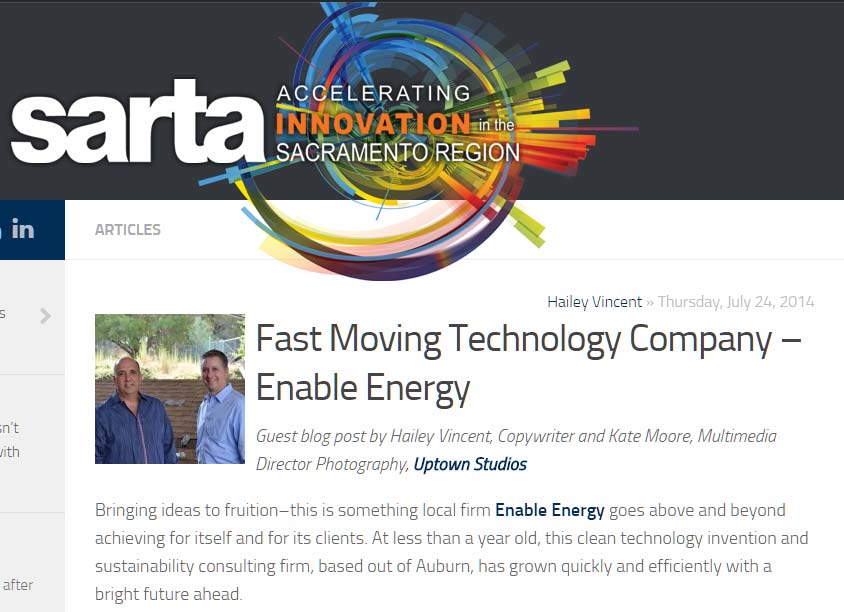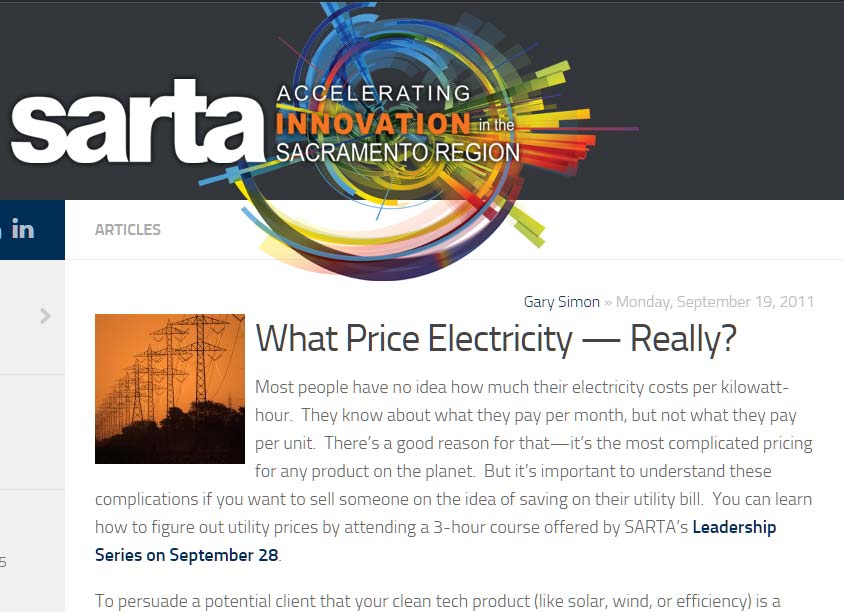
Jul 24, 2014
Bringing ideas to fruition–this is something local firm Enable Energy goes above and beyond achieving for itself and for its clients. At less than a year old, this clean technology invention and sustainability consulting firm, based out of Auburn, has grown quickly and efficiently with a bright future ahead.
After participating in the rapid expansion of Paramount Solar, Todd Lindstrom, principal of Enable Energy, saw an opportunity to start something fresh. After connecting with former colleague Eric Hafter, the two co-founded Enable Energy to bring that opportunity to life.
“There is a huge need to help people in the clean tech industry grow their business ideas faster,” Lindstrom said. “We wanted to do this by creating a fun and engaging work environment, do something meaningful and do it for ourselves.”
Enable Energy goes beyond the development of solar and energy storage products, having a hand in the entire project from beginning to end. The small, powerful team of 11 full-time employees starts by identifying what exactly needs to be done with a project, then creates executive plans and finance plans to manage projects and product development all the way through. They’ve launched two solar racking products to date and have two more nearing completion in just the first five months of business.
 “With such an interesting band of executives, we can come up with amazing ways to tackle tasks in ways that very few companies can do,” Lindstrom said. “We have such a wide range of skills and such a unique infrastructure that really brings products to life.”
“With such an interesting band of executives, we can come up with amazing ways to tackle tasks in ways that very few companies can do,” Lindstrom said. “We have such a wide range of skills and such a unique infrastructure that really brings products to life.”
Enable Energy is hosting three college interns thanks to a Golden Sierra Workforce Investment Board program. The company is designed to be “intern heavy” as the STEM education program is something valued by the company. At Enable Energy, interns are given the opportunity to learn far beyond anything they would be taught inside a classroom. This company goes the extra mile for interns, employees and clients alike.
When given the opportunity to open up their one-of-a-kind company in New York, Los Angeles or San Francisco, Lindstrom and Hafter chose to do it here in the Sacramento area instead.
“This is such a fantastic environment to work in and such a great spot to be,” Lindstrom said. “It had to happen here, it had to be the Sacramento region.”
With a “give it to us and we will get it done” attitude, Lindstrom is confident that there is not a single other company right now that can do what Enable Energy can. This unique company is growing as fast as they possibly can with a promising future.
“I never thought it would go this quickly,” Lindstrom added. “It’s a wild ride but the future looks fantastic.”

Sep 19, 2011
Most people have no idea how much their electricity costs per kilowatt-hour. They know about what they pay per month, but not what they pay per unit. There’s a good reason for that—it’s the most complicated pricing for any product on the planet. But it’s important to understand these complications if you want to sell someone on the idea of saving on their utility bill. You can learn how to figure out utility prices by attending a 3-hour course offered by SARTA’s Leadership Series on September 28.
To persuade a potential client that your clean tech product (like solar, wind, or efficiency) is a smart purchase for them, you need to be able to tell them why – which means, how much they will save. On the other hand, if you’re an electricity customer who wants to lower your bill, you need to know when and how to do that the best. In both cases, it’s all about figuring out the prices. You can’t just look at the utility bill and figure this out—not without knowing a lot more about how the pricing formulas work. Sometimes electricity costs 45 cents per kilowatt-hour, sometimes it costs 9 cents, sometimes it costs 70 cents, sometimes you can avoid only a part of charges for electricity, and sometimes you can avoid them all. The bill doesn’t help much in understanding this. It just adds together all the levels of pricing and shows you the total. And the explanations the utilities publish, while they are very accurate, are hard to follow—unless you get some help.
The prices for electricity became complicated when utilities tried (or were ordered) to publish a fair estimate of what it actually cost to make electricity. In reality, the costs for making electricity were always complicated. Utilities previously made it simple by charging customers pretty uniform average prices. But that hid the fact that the underlying costs vary depending on (for example) time of day, season, level of total demand, prices of the fuel used to make electricity, and level of hydroelectric reservoirs, among many other factors. In order to encourage people to make good choices (buying power from the utility when it is cheap, or reducing usage when it is expensive), utilities needed to make the prices match the real complexity of what it cost to make the power and deliver it—and make that price clear. Unfortunately, prices that are complex are rarely clear.
At its September 28 Leadership Series seminar, SARTA will host rate experts from three utilities who will reveal their secrets of electricity pricing. At this seminar you will learn about multi-part rates, time of use rates, peak load rates, incentive rates, buyback rates, and more. You will also learn how to keep on top of the most current prices, understand when they change and be alert to new features that can help or hurt your business. Nowhere else are you going to be able to learn all of these things in such a short course, that is specific to the three utilities serving the Sacramento region. If you are trying to sell clean tech products that replace utility power—or just if you want to learn how to choose rates that can help you lower your bill— join us at this seminar. Sign up soon, though, it’s filling up fast.

 “With such an interesting band of executives, we can come up with amazing ways to tackle tasks in ways that very few companies can do,” Lindstrom said. “We have such a wide range of skills and such a unique infrastructure that really brings products to life.”
“With such an interesting band of executives, we can come up with amazing ways to tackle tasks in ways that very few companies can do,” Lindstrom said. “We have such a wide range of skills and such a unique infrastructure that really brings products to life.”
